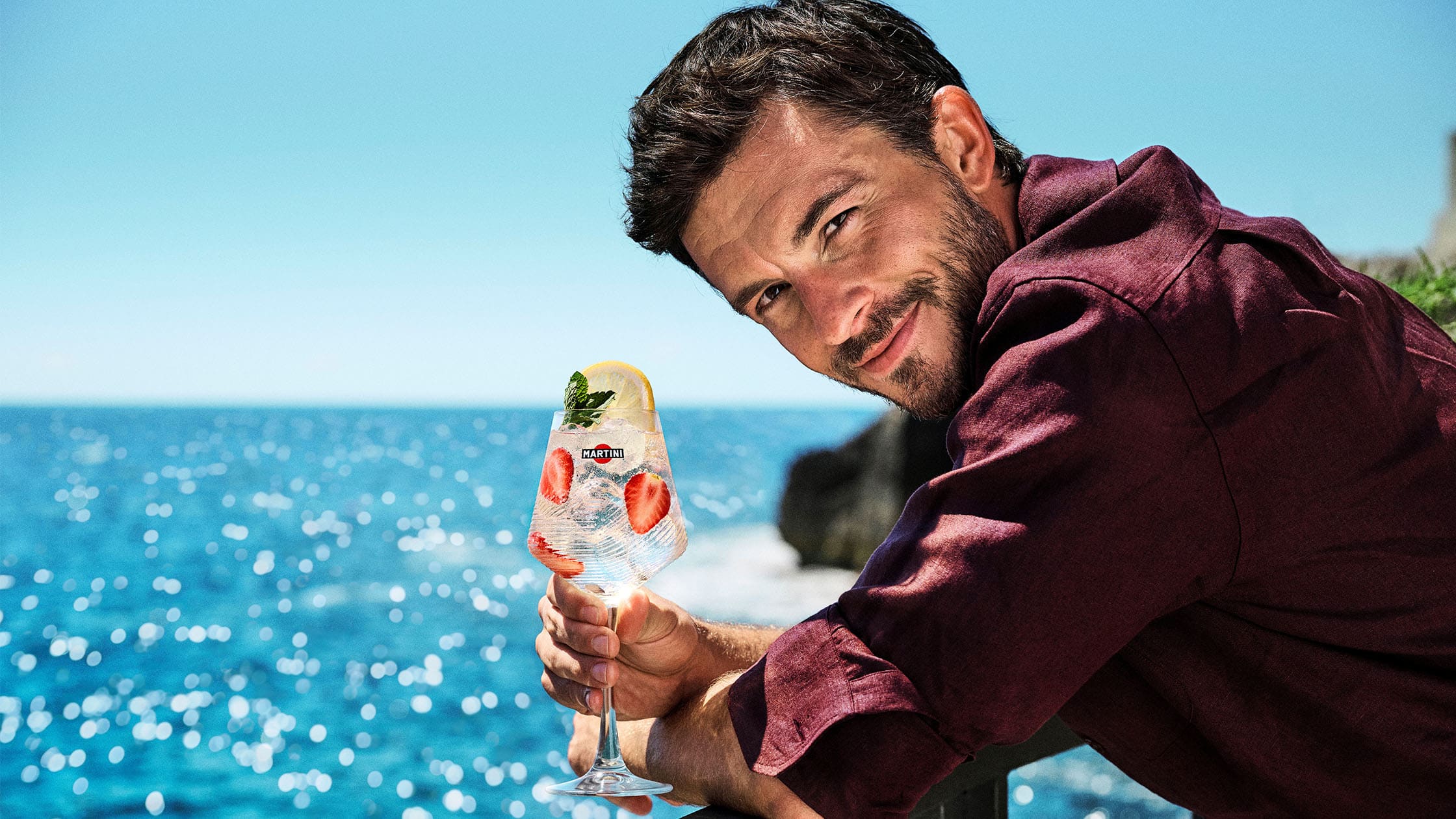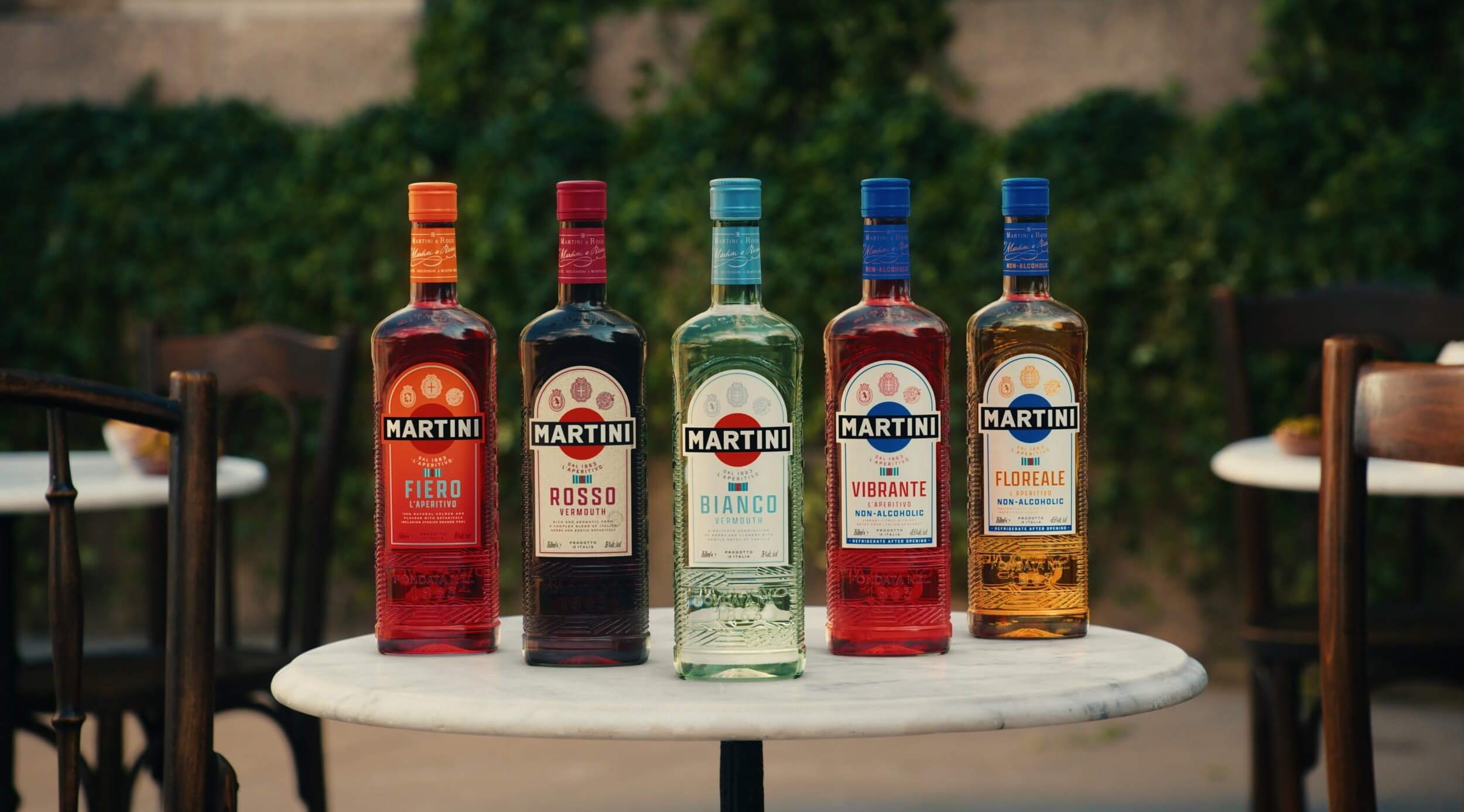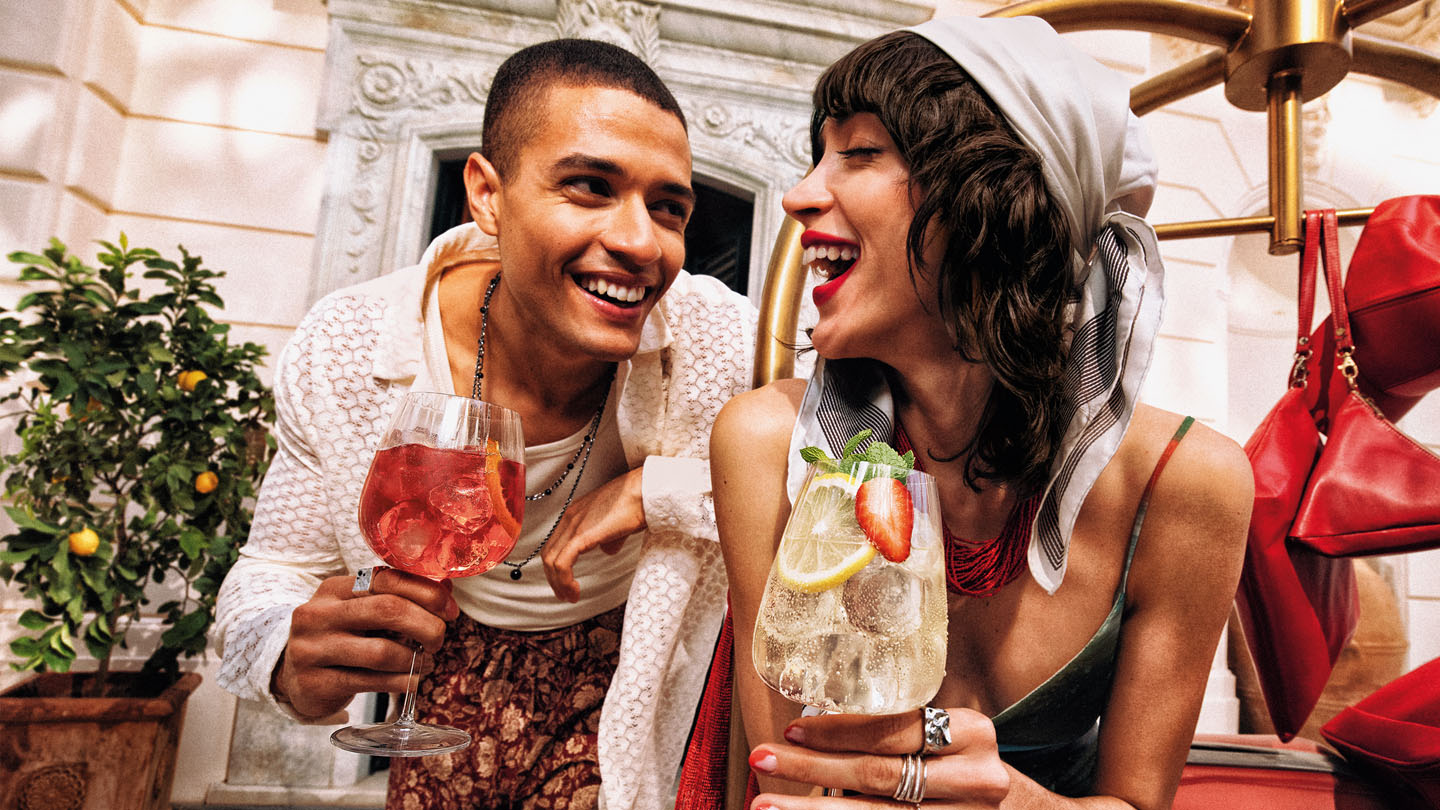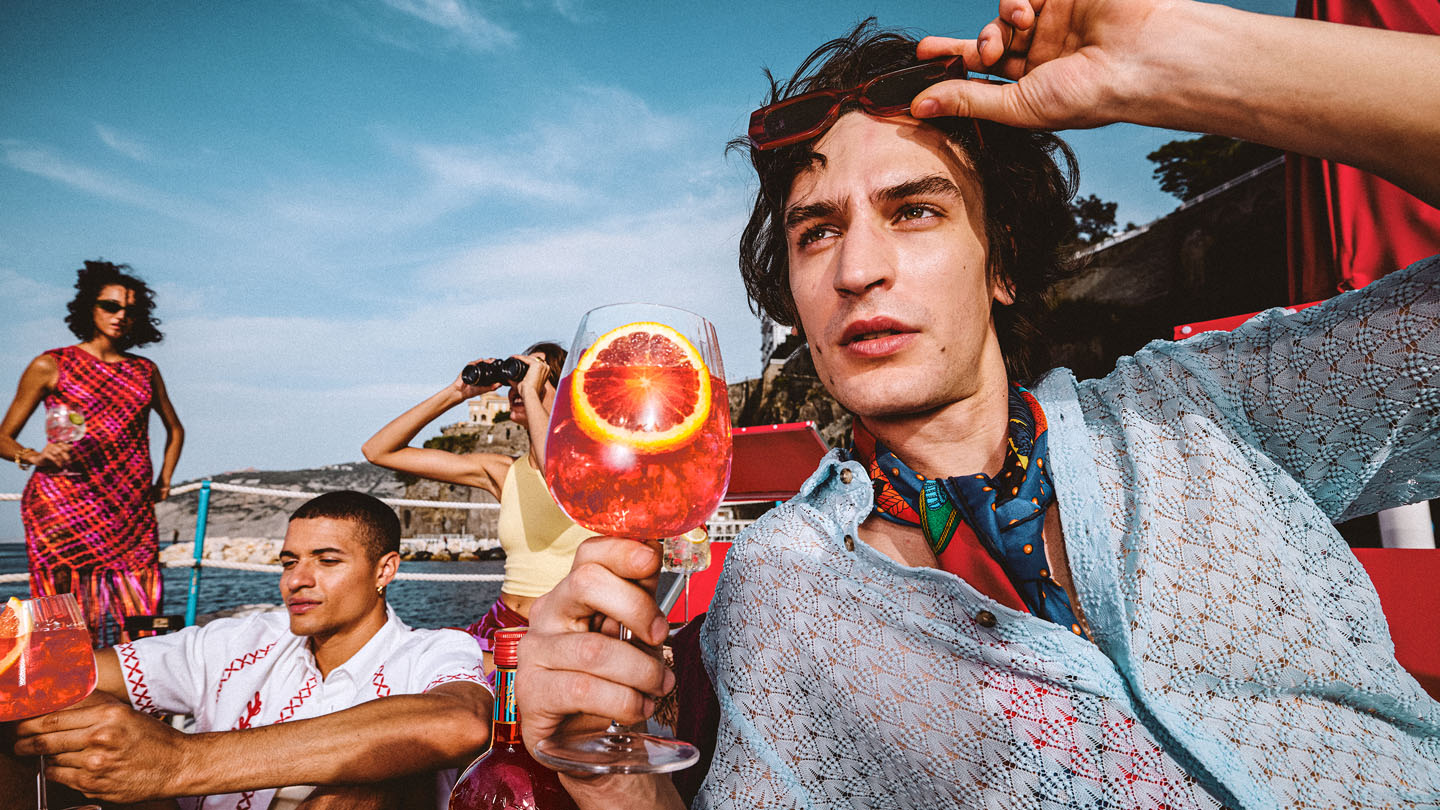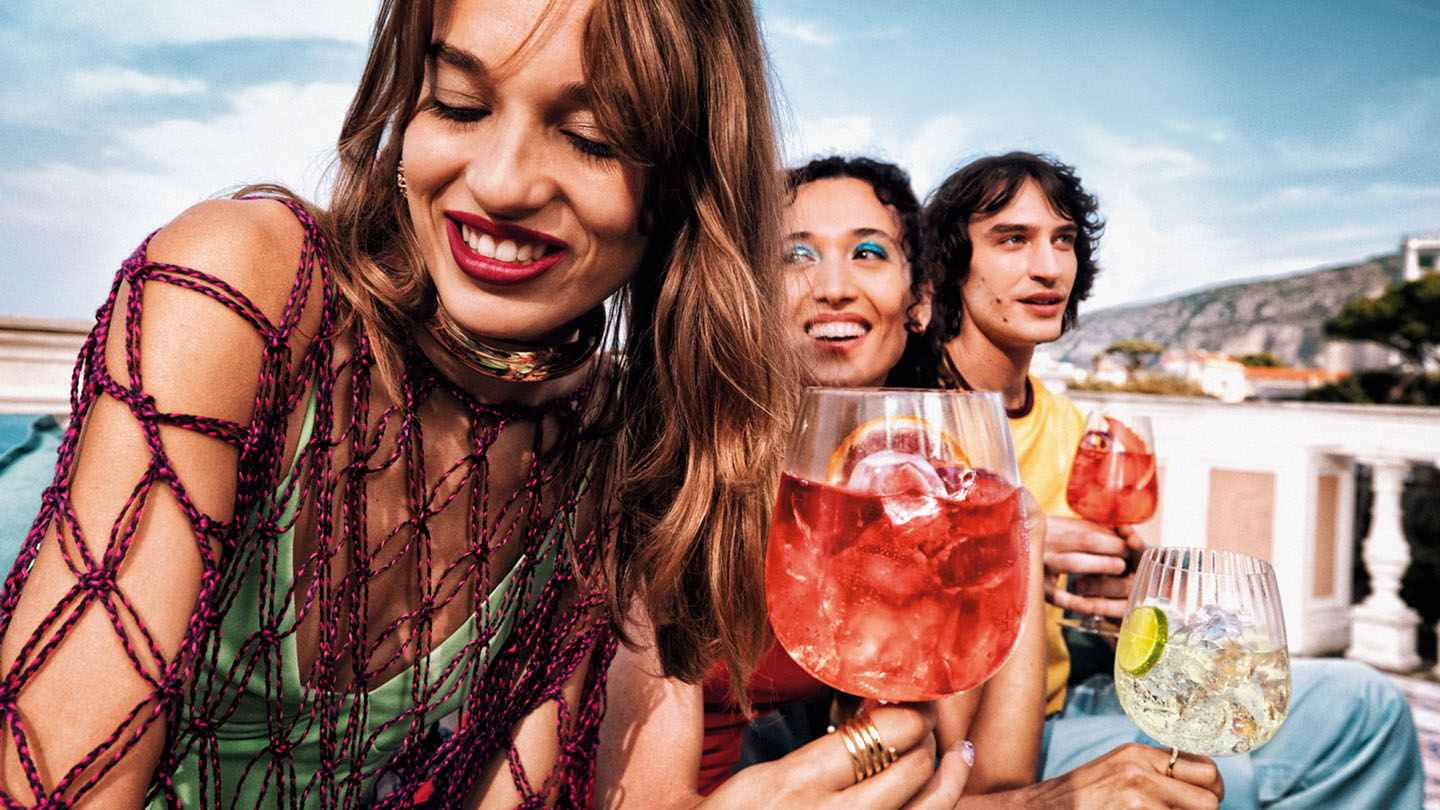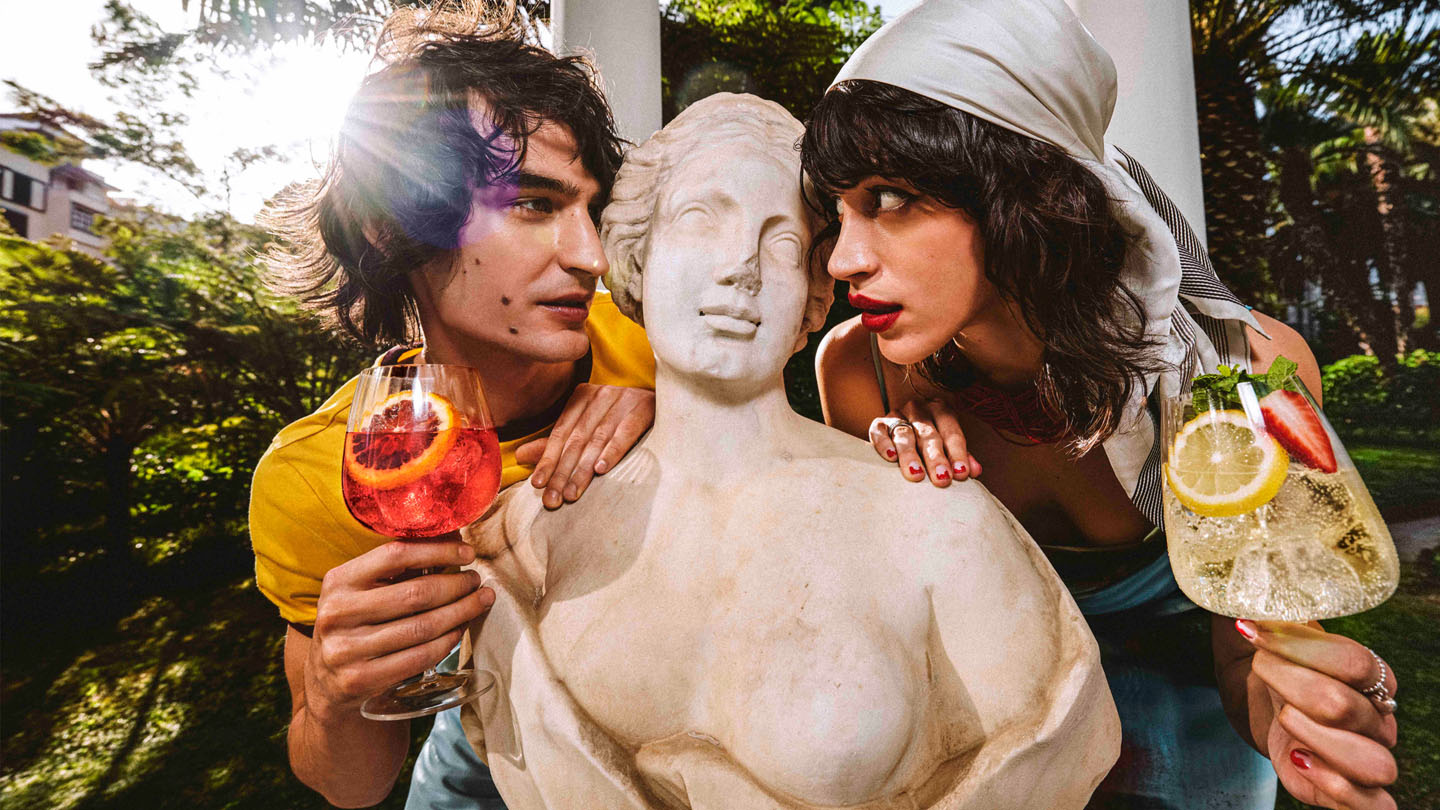JONATHAN BAILEY GOES ‘OFF SCRIPT’ IN ITALY WHILE DISCOVERING HIS NEW CO-STAR: THE MARTINI SPRITZ.
Our bold new collaboration with acclaimed actor Jonathan Bailey is calling on audiences to break from routine and try a different path. Together, we’re inspiring people to go ‘Off Script’ this summer – swapping predictable plans for spontaneous moments.
Filmed in sun-soaked Southern Italy during a rare escape in his busy schedule – a favourite spot he returns to every year – Bailey leaves his carefully scripted characters and cult on-screen roles behind to embrace a summer of spontaneity, effortless Italian style, and a MARTINI Spritz. Along the way, he playfully invites the world to try something different and discover the joy of going ‘Off Script’.

“Going off script is the ultimate way to allow space for fun, and new experiences,” says Bailey. “Unplanned moments end up being the most unforgettable. This summer, I invite everyone to take a breath, dive in, swerve off piste and be playful. Live a little differently… with a MARTINI Spritz in hand, of course.”
Crisp, bright, and exceptionally stylish, crafting the perfect MARTINI Bianco Spritz serve couldn’t be easier in three steps. Add 3 parts MARTINI Prosecco, 2 parts MARTINI Bianco and 1 part Soda to a spritz glass with ice. Stir gently and garnish with lemon slice, mint sprig and slices of strawberry. The result? A beautifully balanced spritz with delicate vanilla and citrus notes that’s set to be the must-try drink of the summer.

Fans can sip like Bailey in their own cities and discover an Italian icon at TERRAZZA MARTINI – a new pop-up experience touring over 30 ‘Off Script’ rooftop, bar and piazza locations across Europe – including Barcelona, Berlin, Milan, Madrid and Antwerp.
With the arrival of Jonathan as this summer’s ‘MARTINI Man’; the TERRAZZA MARTINI embarking on a tour across Europe; and the MARTINI Bianco Spritz taking the spotlight, Off Script Summer with MARTINI starts now — and everyone’s invited.

NEW CONTEMPORARY BOTTLE
Our new contemporary bottle gives MARTINI a new distinctive, stylish design inspired by the arched walkways of Turin, Italy contributing to an overall reduction in our carbon footprint.

INTRODUCING THE MARTINI BIANCO SPRITZ
Elevate your next aperitivo with a MARTINI Bianco Spritz! With vanilla notes from MARTINI Bianco adding a delicate botanical flavour to the crisp prosecco, this aperitivo is a sweet, aromatic experience.

MAKE YOUR OWN
MARTINI Bianco Spritz
- 50
ml MARTINI® Bianco - 75
ml MARTINI® Prosecco - 25
ml Soda -
Fresh mint, slices of lemon and strawberry to garnish
- Add all ingredients to a Spritz glass with ice.
- Stir gently.
- Garnish and enjoy.
Spritz Cocktail Recipes
Here at MARTINI, we cherish those moments spent basking in the sun with good company. Spritz cocktails are a traditional staple of aperitivo, many Italians enjoy a refreshing Spritz on a long summer’s evening. Crafting the perfect Spritz couldn’t be easier, with most of our recipes calling for equal parts of Martini Vermouth, soda water and prosecco. Effortless to create but bursting with complex flavours, the Spritz cocktail is the perfect companion for warm afternoons, evening aperitivo and even for brightening winter nights. Whether you enjoy a burst of citrus or a dash of sweetness, from our iconic MARTINI Fiero Spritz to our non-alcoholic MARTINI Floreale Spritz, we’ve got you covered.
MARTINI® Fiero Spritz
Bold • Bittersweet • Fresh Citrus
A modern twist on the classic Sbagliato transformed into a bold spritz. We recommend using MARTINI® Rosé Extra Dry to introduce an element of vibrancy that marries perfectly with fruity Fiero. In a pinch, prosecco or regular sparkling wine can be used to create a delicate but flavourful cocktail with the bittersweet orange notes of Fiero taking centre stage.
MAKE YOUR OWN
Martini Fiero Spritz
- 50
ml MARTINI® Fiero - 75
ml MARTINI® Rosé Extra Dry - 25
ml Soda -
Pink grapefruit slice to garnish
- Add all ingredients to a Spritz glass with ice.
- Stir gently.
- Garnish and enjoy.
MARTINI® Bianco Spritz
Sophisticated • Subtle Spice • Vanilla
With sweet vanilla notes from MARTINI® Bianco adding a delicate botanical flavour to the crisp prosecco, this aperitivo is a sweet, aromatic experience.
MAKE YOUR OWN
MARTINI Bianco Spritz
- 50
ml MARTINI® Bianco - 75
ml MARTINI® Prosecco - 25
ml Soda -
Fresh mint, slices of lemon and strawberry to garnish
- Add all ingredients to a Spritz glass with ice.
- Stir gently.
- Garnish and enjoy.
MARTINI® Non-Alcoholic Floreale Spritz
Sophisticated • Aromatic • Floral
With delicate floral notes of Floreale, lightened with bubbly soda water and crisp apple juice, this bright aperitivo is an elegant non-alcoholic option for staying refreshed under the sun.
MAKE YOUR OWN
MARTINI Non-Alcoholic Floreale Spritz
- 75
ml MARTINI® Floreale - 25
ml Apple Juice - 50
ml Soda -
Ice -
Mint Sprig to garnish
- Fill a wine glass with ice.
- Pour the MARTINI® Floreale and apple juice into the glass.
- Top with soda water.
- Stir gently for a few moments.
- Garnish with a mint sprig.
MARTINI® Non-Alcoholic Vibrante Spritz
Robust • Refreshing • Grapefruit & Bergamot
The complex citrus notes of MARTINI® Vibrante shine in this bright, fizzy, and refreshing drink thanks to the bubbling soda water and bitter edge of grapefruit juice, making this Spritz your perfect non-alcoholic aperitivo companion.
MAKE YOUR OWN
MARTINI Non-Alcoholic Vibrante Spritz
- 75
ml MARTINI® Vibrante - 25
ml Fresh Grapefruit juice - 50
ml Soda -
Ice -
Grapefruit slice to garnish
- Fill a wine glass with ice.
- Pour the MARTINI® Vibrante and grapefruit juice into the glass.
- Top with soda water.
- Stir gently for a few moments.
- Garnish with a grapefruit slice.
MARTINI® Rosato Spritz
Elegant • Aromatic • Sweet Spices
Light and aromatic, MARTINI® Rosato is the perfect complement to fizzing prosecco on a warm day. With rich notes of cloves, cinnamon, and nutmeg alongside a dash of citrus, this Spritz cocktail is a lightly spiced delight.
MAKE YOUR OWN
MARTINI Rosato Spritz
- 75
ml MARTINI® Prosecco - 50
ml MARTINI® Rosato - 25
ml Soda Water -
Ice -
Raspberries -
A lemon wheel
- Fill a wine glass with ice.
- Pour the MARTINI® Rosato and MARTINI® Prosecco into the glass.
- Top with soda water.
- Stir gently for a few moments.
- Garnish with raspberries, a lemon wheel, and a sprig of rosemary.
Introducing MARTINI Non-Alcoholic Aperitivo
Since 1863, MARTINI has brought people together through the quintessentially Italian experience of Aperitivo. With recipes passed down through generations of master blenders, MARTINI is challenging the perceptions of non-alcoholic drinks with a range that demonstrates amazing choice and taste without compromise. If you are moderating alcohol, our Non-Alcoholic Aperitivo is the perfect base for any mocktail, so you never have to miss out on MARTINI time.
MAKE YOUR OWN
MARTINI Non-Alcoholic Vibrante Spritz
- 75
ml MARTINI® Vibrante - 25
ml Fresh Grapefruit juice - 50
ml Soda -
Ice -
Grapefruit slice to garnish
- Fill a wine glass with ice.
- Pour the MARTINI® Vibrante and grapefruit juice into the glass.
- Top with soda water.
- Stir gently for a few moments.
- Garnish with a grapefruit slice.
MAKE YOUR OWN
MARTINI Non-Alcoholic Floreale Spritz
- 75
ml MARTINI® Floreale - 25
ml Apple Juice - 50
ml Soda -
Ice -
Mint Sprig to garnish
- Fill a wine glass with ice.
- Pour the MARTINI® Floreale and apple juice into the glass.
- Top with soda water.
- Stir gently for a few moments.
- Garnish with a mint sprig.
MARTINI Non-Alcoholic Vibrante & Tonic
- 75
ml MARTINI Vibrante - 75
ml Tonic Water -
Orange Wheel to garnish
- Add all ingredients to a Spritz glass with ice
- Stir gently
- Garnish and enjoy

MARTINI Non-Alcoholic Floreale & Tonic
- 75
ml MARTINI Floreale - 75
ml Tonic Water -
Lime Wheel to garnish
- Add all ingredients to a Spritz glass with ice
- Stir gently
- Garnish and enjoy

Are mocktails non-alcoholic?
Yes, a mocktail is a cocktail-style drink usually made by the mixing of different juices and alcohol alternatives. They are as flavourful and refreshing as a classic cocktail – just without the alcohol.
Are non-alcoholic cocktails healthy?
This would depend on the other ingredients you use to create your mocktail. However, everything should always be enjoyed in moderation, even delicious non-alcoholic cocktails.
Do you want to know more about non-alcoholic drinks or lowering your alcohol intake? Take a look at our guide to all things alcohol-free.
What pairs with a non-alcoholic cocktail?
The key to the perfect pairing is finding complementary or contrasting flavours. When enjoying MARTINI Non-Alcoholic Floreale, you can pair the floral drink with a range of light Italian appetisers such as olives and bruschetta.
Our MARTINI Non-Alcoholic Vibrante is the perfect accompaniment for charcuterie or pizzette. Try them out for yourself and discover your favourite Aperitivo combination.
Quality Ingredients
Our Non-Alcoholic Aperitivo begins the same way as our alcoholic drinks. The same quality of wines, herbs, and botanicals are selected by master herbalists and sourced from our growers. Combining over 150 years of traditional expertise with a modern twist, we bring the vibrancy and complexity of our ingredients to life.
A craft that takes time and care
After we slowly remove the alcohol from our wine, preserving the authentic characteristics, we infuse the flavours of our superior botanicals, including Artemisia, Roman Chamomile and Bergamot. The result is a non-alcoholic Aperitivo that’s unmistakably MARTINI.
The Spritz is a refreshing Italian aperitif made by combining wine, a bittersweet liqueur and soda water. Although enjoyed year-round, you will commonly find a Spritz being sipped in the summer as the lightness of the drink is the perfect accompaniment to a warm day. If you fancy sipping on a Spritz without the alcohol, take a look at our thirst-quenching non-alcoholic Spritz cocktail recipes.
MARTINI Non-Alcoholic Floreale Spritz
Our MARTINI Floreale is a deliciously floral aperitif with botanical flavours including Artemisia and Roman Chamomile. Using this alcohol-free Aperitivo in a Spritz allows the floral flavours to take centre stage as the apple juice complements and the soda water enhances the tasting profile. You can make your own MARTINI Non-Alcoholic Floreale Spritz with ease thanks to our recipe and enjoy this light cocktail during a sunny afternoon or before a meal as often as you like.
MAKE YOUR OWN
MARTINI Non-Alcoholic Floreale Spritz
- 75
ml MARTINI® Floreale - 25
ml Apple Juice - 50
ml Soda -
Ice -
Mint Sprig to garnish
- Fill a wine glass with ice.
- Pour the MARTINI® Floreale and apple juice into the glass.
- Top with soda water.
- Stir gently for a few moments.
- Garnish with a mint sprig.
MARTINI Non-Alcoholic Vibrante Spritz
The MARTINI Vibrante is a citrus Aperitivo boasting Artemisia and Bergamot flavours. Add some grapefruit juice and soda water, and you’ve got a delicious MARTINI Non-Alcoholic Vibrante Spritz.This alcohol-free cocktail combines the vibrant citrus flavours with the slightly bitter grapefruit, all rounded off with soda water to create a refreshing alcohol alternative.
MAKE YOUR OWN
MARTINI Non-Alcoholic Vibrante Spritz
- 75
ml MARTINI® Vibrante - 25
ml Fresh Grapefruit juice - 50
ml Soda -
Ice -
Grapefruit slice to garnish
- Fill a wine glass with ice.
- Pour the MARTINI® Vibrante and grapefruit juice into the glass.
- Top with soda water.
- Stir gently for a few moments.
- Garnish with a grapefruit slice.
Enjoying a Non-Alcoholic Spritz
Whether you prefer to sip on a Spritz on a warm afternoon in your garden or as an aperitif, choosing an alcohol-free alternative doesn’t mean you have to sacrifice the flavour or visual aesthetics of these classic cocktails. At MARTINI we have the perfect non-alcoholic Aperitivos to create delicious Spritz cocktails and more.
An Aperitivo is usually a light, carbonated low-alcoholic beverage. This Italian custom of a drink with your meal stimulates the appetite and palate. If you’re lowering your alcohol intake or don’t drink at all, we’ve put together our favourite non-alcoholic Aperitivo cocktails for you to enjoy at home.
Dolce Verde Cocktail
Created by La Maison Wellness, the Dolce Verde is as refreshing as it is delicious. Made with our Non-Alcoholic Floreale, it’s the perfect drink to get your taste buds ready for the meal ahead. Perfectly paired with taralli, olives or bruschetta to complement the herbal and citrus notes.
Make your own
Dolce Verde Cocktail
- 50
ml MARTINI Non-Alcoholic Floreale - 20
ml Apple Juice - 20
ml Coconut Water - 10
ml Cucumber Juice -
Top up with kombucha, mint & cucumber to garnish
- Pack a wine glass with ice. Pour 50ml of MARTINI Non-Alcoholic Floreale, 20ml of apple juice, 20ml coconut water, 10ml cucumber juice.
- Top up with kombucha.
- Stir gently to mix ingredients and garnish with mint & cucumber.

MARTINI Non-Alcoholic Floreale Spritz
This floral cocktail boasts botanical flavours alongside apple juice to create the ultimate non-alcoholic Aperitivo. Easy to make (and even easier to drink), you can sip on your non-alcoholic Spritz as you wait for dinner to be served.
MAKE YOUR OWN
MARTINI Non-Alcoholic Floreale Spritz
- 75
ml MARTINI® Floreale - 25
ml Apple Juice - 50
ml Soda -
Ice -
Mint Sprig to garnish
- Fill a wine glass with ice.
- Pour the MARTINI® Floreale and apple juice into the glass.
- Top with soda water.
- Stir gently for a few moments.
- Garnish with a mint sprig.
MARTINI Non-Alcoholic Vibrante Spritz
Using MARTINI Vibrante, this citrus Spritz is the perfect pre-meal accompaniment. Simply add grapefruit juice and soda to create this fruity alcohol-free Aperitivo. You can choose to pair this tart mocktail with charcuterie, pizzette and simple crisps to complement the flavour profiles and create a beautiful balance.
MAKE YOUR OWN
MARTINI Non-Alcoholic Vibrante Spritz
- 75
ml MARTINI® Vibrante - 25
ml Fresh Grapefruit juice - 50
ml Soda -
Ice -
Grapefruit slice to garnish
- Fill a wine glass with ice.
- Pour the MARTINI® Vibrante and grapefruit juice into the glass.
- Top with soda water.
- Stir gently for a few moments.
- Garnish with a grapefruit slice.
Enjoying Aperitivo
Aperitivo is an Italian tradition that anyone can enjoy, either with or without alcohol. Our alcohol-free aperitifs will ensure you can relax and socialise with a delicious drink before your meal.
Can an aperitif be non-alcoholic?
Yes, although typically a low-alcoholic drink, you can enjoy an alcohol-free aperitif. The custom is to socialise before dinner and open up your taste palate, which can be achieved just as easily with a non-alcoholic aperitif cocktail.
What makes a cocktail an aperitif?
Typically, an aperitif cocktail is low in alcohol (or none at all). This is to stimulate your appetite without dulling the palate with overwhelming flavours or high alcohol content.
Classic Italian Cocktails
Italy’s rich culinary tapestry and vibrant aperitivo culture has led to the creation of cocktails with a timeless allure.
Explore and celebrate Italy’s most famous and delicious cocktails, and get inspired by the flavours, aromas, and spirit of aperitivo with our easy Italian cocktail recipes.
Famous Italian Cocktails
Handpicked by our MARTINI cocktail experts, here are our favourite classic Italian cocktail recipes. Whether you’re looking for inspiration for your next trip to Italy, or wanting to drink the Italian way at home, these cocktails capture the essence of aperitivo and are best enjoyed with friends, family and classic Italian dishes.
MARTINI Negroni
The MARTINI Riserva Speciale Rubino and Riserva Speciale Bitter come together perfectly to deliver the Master Blenders ultimate Negroni cocktail. A perfect balance of sweetness, bitterness and distinctive botanicals with MARTINI’s vibrant vermouth and complex bitters.
Salty and fatty dishes are the perfect pairing for a Negroni cocktail, softening the intense aromatic bitterness with every sip. The complex flavours of cured meat or the clean, cool simplicity of beef tartare or burrata pair fabulously with this bright and tasteful Negroni.
MAKE YOUR OWN
MARTINI Negroni
- 30
ml MARTINI® Riserva Speciale Rubino - 30
ml MARTINI® Riserva Speciale Bitter - 30
ml BOMBAY SAPPHIRE® Gin -
Orange Wedge to garnish
- Fill a tumbler with ice cubes.
- Pour the ingredients in and stir gently for dilution.
- Add the orange wedge to garnish.
MARTINI Rosso Americano
The Americano is a drink with mythical origins. The mentions of a cocktail made with vermouth, bitter, and soda date back to the 1880s, but the first official recipe for an “Americano” appeared only a few decades later. In Italy, the cocktail is documented in a recipe book from 1920.
Thanks to its extensive historical archives, MARTINI has begun to shed light on the mysterious story of this cocktail, one that intertwines with the history of an aperitif called “Americano,” crafted by the company since 1875. By 1906, Martini & Rossi was producing a “Vermouth with Bitter Americano,” recommended to be enjoyed with soda water and a twist of lemon. From the 1930s onward, the Americano cocktail became a fixture in cocktail books and MARTINI advertisements, often served into an highball glass.
MAKE YOUR OWN
MARTINI Rosso Americano
- 35
ml MARTINI Rosso - 35
ml MARTINI Bitter - 70
ml Soda -
Orange Slice to garnish
- Add all ingredients to a tumbler with ice.
- Stir gently.
- Garnish and enjoy.
MARTINI Manhattan
The Manhattan cocktail is complex and warming with a delicate touch of sweetness, for those that enjoy multiple layers to their cocktail experience. Served in a classic Martini cocktail glass, this drink exudes elegance with every sip.
The bitter-sweet power of a Manhattan cocktail makes it the perfect pairing to the sweet flavours of fig, creamy goat cheeses, and crispy rucola with flatbread.
Make your own
MARTINI Manhattan
- 60
ml Rye Whiskey - 30
ml MARTINI Riserva Speciale Rubino - 2.5
ml Maraschino Liquer -
dash of Angostura Bitters -
Marachino Cherry to garnish
- Fill a mixing glass with ice cubes.
- Pour in the ingredients and stir for 20 seconds.
- Strain into a Martini cocktail glass and garnish.
What are the traditional Italian pre-dinner drinks?
The concept of aperitivo is built into Italian culture and community. It’s a time where friends and family can gather to socialise and enjoy light drinks and snacks before dinner. Traditionally, these drinks are simple spritz cocktails, easy to make and refreshing to drink after a long day.
In a country where every meal is a celebration of flavour, MARTINI has been an essential companion to the Italian aperitivo since its founding in 1863. Read more about MARTINI’s Italian story.
To learn more about aperitivo cocktails and culture, check out our guide to aperitivo.
Whether you’re committing to a New Year’s Resolution, seeking a lifestyle change, or simply looking to cut down on alcohol after an indulgent festive season, there are many reasons to lower your alcohol intake. As Dry January becomes increasingly popular, we’ve outlined the benefits of drinking in moderation or enjoying non-alcoholic drinks.
Benefits of Alcohol-Free Drinks
Everything in moderation is a good motto to live by, and this includes drinking alcohol. With MARTINI, you can easily join in or host a no-low gathering at home with finesse and sophistication, thanks to our Non-Alcoholic Aperitivo. The social element of drinking can be enjoyed without alcohol – and without compromising on taste or flavour.
What is the difference between non-alcoholic and low abv?
Although both drinks are low in alcohol the key difference is the level of alcohol content. A non-alcoholic beverage will have less than 0.5% ABV, while low-ABV drinks typically range from 0.5% to 4% ABV depending on your country. Depending on the individual and volume of alcohol in low ABV, users may still experience a noticeable alcohol taste or effect.
What is dry January?
Dry January is a wellness campaign that began in the UK in 2013 and encourages people to abstain from alcohol for the month. However, this campaign is now being seen all over the globe. The aim is to promote the physical and mental health benefits of reducing your alcohol consumption. This voluntary challenge can be a great way to start the New Year and rests entirely on the individual. You can cut out alcohol completely for the whole month or simply drink less!
What are the benefits of dry January?
Taking a month to lower your alcohol intake can have physical health benefits and practical ones like saving money. The exact benefits of voluntarily abstaining from alcohol for a month will vary by individual. Still, you can rest assured that regardless of your motivations for seeking alcohol alternatives, MARTINI has got you covered with our non-alcoholic drinks and mocktail recipes.
How to do dry January?
If Dry January (or any other time of the year), is a challenge you’d like to take on, you should first set a clear goal. This can be to have no alcohol for the entire month or set a limit, such as to only have one glass of MARTINI Prosecco on a Saturday evening.
You can also reward yourself at the end of the month for completing the challenge. However, it’s important to remember that Dry January is a personal choice, and if you have any setbacks, learn from them and continue your journey of reducing alcohol intake and responsible drinking.
Cut out alcohol, without compromise
With MARTINI, you can drink in moderation or cut out alcohol entirely, without compromising on flavour. From creating a non-alcoholic cocktail to presenting your alcohol alternative in a fancy glass with a garnish, reducing your alcohol intake doesn’t mean your drinks have to be boring!
A Guide To The Martini Cocktail
In this guide, we’ll explore the origins of the Martini cocktail, the history of our MARTINI brand, and dive into popular variations, such as the Dry Martini cocktail, the Perfect Martini cocktail, and the Dirty Martini cocktail, to help you find your favourite serve. As a bonus, we’ll share our own classic Martini cocktail recipe, so you can discover how to make this classic drink with the finesse it deserves.
The history of the Martini cocktail and its origin
The origins of the Martini cocktail are a little unclear, but there are some widely accepted theories. The origins of the name itself are up for debate, with ‘Martinez’ and ‘Martini’ cocktail used interchangeably to refer to a gin and vermouth cocktail in 1880s bartenders’ manuals.
The city of Martinez, California claims ownership of the Martini cocktail. Legend has it a local tavern owner invented the ‘Martinez Special’ cocktail during the goldrush to celebrate a huge haul from a successful miner. O.H Byron’s The Modern Bartender Guide (1884) also lists the famous cocktail as a ‘Martinez’ but describes it as a variation of a Manhattan cocktail, which has a whiskey base rather than gin. One theory even credits us with popularising the name ‘Martini’ as an abbreviation of Martini & Rossi.
Compared to modern Martini cocktails, the original variations were typically sweet. It’s theorised that the drink became progressively drier partially due to the emergency of London Dry Gin. MARTINI, then known as Martini & Rossi, launched MARTINI Extra Dry vermouth, popularising the dry martini cocktail in the US at the turn of the 20th Century.
Regardless of how the Martini cocktail came to be, its iconic status is undeniable. American critic H.L. Mencken once described the drink as “the only American invention as perfect as the sonnet,” which may be high praise, but we’re inclined to agree.
How to create the classic Martini cocktail
This contemporary vermouth is a complex blend of citrus and bittersweet orange with crisp white wines that creates a zesty and refreshing cocktail when mixed with bubbly tonic water.
The one and only Martini cocktail is a timeless classic ordered by everyone from Churchill to Hemingway. While the precise recipe is a matter of dispute, here is what we believe to be the perfect ratio.
Make your own
Gin Martini Cocktail
- 25
ml MARTINI® Extra Dry - 75
ml BOMBAY SAPPHIRE® Gin
- Fill a mixing glass with ice cubes.
- Pour in MARTINI® Extra Dry vermouth and gin. Stir for about 20 seconds.
- Strain into a well-chilled Martini cocktail glass.
- Twist a peel over the cocktail, to release the oils, then drop into the drink as a garnish or garnish with an olive.
What does a Martini cocktail taste like?
The Martini cocktail has a crisp and elegant taste, characterised by botanical nuances and a slight bitterness. When crafted with gin, the presence of juniper and herbal complexities culminates in a dry finish. Alternatively, opting for vodka yields a smoother flavour profile, with subtle sweetness and a neutral, clean backdrop. High-quality ingredients, precise measurements, proper chilling, and appropriate glassware are paramount for the perfect Martini cocktail, enhancing its delicate balance and sophistication.
How to serve a Martini cocktail
To serve a Martini cocktail, start by selecting either gin or vodka as your base spirit. The only other ingredient in this cocktail is vermouth, which adds both depth and complexity. The amount of vermouth in the cocktail typically indicates how ‘dry’ the Martini cocktail is.
The drink can be served straight up, without ice, or on the rocks, with ice. Martini cocktails are typically prepared with an olive garnish or a twist of lemon peel. The choice of garnish can subtly alter the flavour profile, with olives adding a briny note and lemon peel a taste of citrus.
The best thing about Martini cocktails is how they can be customised to your personal tastes, and there are several classic variations of the cocktail worth exploring. Some of the most famous include the Dirty Martini cocktail, incorporating olive brine for a salty twist, or the Sloe Gin Martini cocktail which switches out traditional gin for sloe gin.
Here are some classic Martini cocktail variations to help you find your style:
Dry Martini Cocktail
Martini cocktails are commonly served dry, but some people prefer ‘dry’ or ‘extra-dry’ martinis. How ‘dry’ the Martini is reflects the quantity of vermouth in the cocktail. ‘Extra-dry’ indicates that very little vermouth has been added to the cocktail, making the gin the primary focus.
Wet Martini Cocktail
The opposite to the Dry Martini, a Wet Martini uses more vermouth proportional to the base spirit. The vermouth, with its complex and aromatic flavour profile, used in the cocktail, the sweeter and richer the overall taste of your Martini cocktail.
Perfect Martini Cocktail
The perfect Martini cocktail incorporates both dry and sweet vermouth in its creation. With a fifty-fifty ratio of dry vermouth and sweet vermouth, typically MARTINI Extra Dry, alongside the base spirit, the cocktail has a well-balanced but complex flavour profile. The dry vermouth adds herbal and floral notes, whilst the sweet vermouth adds a subtle sweetness and rich twist to this classic Martini cocktail variant.
Dirty Martini Cocktail
A small amount of olive brine distinguishes the Dirty Martini cocktail from a classic Dry Martini cocktail. This addition adds a savoury, briny flavour to the cocktail, giving it a slightly salty and more robust taste than traditional Martini cocktails. The name ‘Dirty Martini’ comes from the cloudy appearance the olive brine gives the cocktail. Another variant of the Dirty Martini cocktail is a Filthy Martini cocktail, which includes a larger portion of olive brine, giving the drink a cloudier, dirtier appearance and an even saltier flavour.
Shaken or Stirred?
The long-raging debate of shaken versus stirred refers to the method of mixing a Martini cocktail. The phrase is associated with the character James Bond, who famously ordered his Martini cocktail “shaken, not stirred” in the iconic film series, adding to the image of the Martini cocktail as a symbol of class and sophistication. Gently stirring the ingredients together with the ice creates a silky smooth and crystal-clear cocktail with minimal dilution and a colder finish. Shaking your Martini cocktail in a shaker produces a cloudier cocktail due to the additional aeration, along with more dilution and a subtly warmer temperature.
As each method slightly alters the taste and texture of the cocktail, ultimately, whether you have your Martini cocktail shaken or stirred depends on your personal preference.

Our MARTINI brand history
What other cocktails can you make with MARTINI?
MARTINI’s vermouth isn’t just for making Martini cocktails. Our vermouths each have a unique flavour profile and are a delicious and elegant complement to many spirits, liquors and mixers.
Some of our favourite classic cocktails include:
• The famous Negroni, a timeless Italian blend of silky MARTINI Speciale Rubino and MARTINI Riserva Speciale Bitter with quality gin.
• The elegant Manhattan, adding a burst of maraschino liqueur and angostura bitters to smooth whiskey and our rich vermouth.
• The bright Americano, a zesty blend of MARTINI vermouths and soda water.
For a unique twist on traditional mixes try:
• Our Sbagliato Ambrato, a twist on the classic Negroni that uses MARTINI Riserva Speciale Ambrato for a floral and honeyed twist.
• Our Spritz cocktails. MARTINI vermouth elevates the classic Spritz. If you’re looking for bittersweet citrus flavours and a fruity twist, try MARTINI Fiero.
A Guide to Vermouth
Vermouth is a fortified wine, infused with artfully selected botanicals, herbs and spices for a complex and vibrant flavour profile. Each type of vermouth has been curated for a specific taste, ranging from floral and herbal notes to subtle sweetness. This versatility makes vermouth a perfect ingredient for classics like the Martini cocktail or a Negroni.
In Italy, where vermouth was born and continues to thrive, it’s customary to enjoy the drink during aperitivo – a social pre-dinner ritual celebrated with drinks, light snacks, and time to unwind with friends and family. So, whether you’re sipping vermouth neat or mixing it in a refreshing cocktail, join us as we explore all things vermouth.
What is Vermouth?
Vermouth has two distinct forms; a ‘dry’ vermouth, characterised by its pale appearance and bitter notes, and a red, ‘sweet’ vermouth with a richer, sweeter flavour. The latter was invented in Turin around 1780. The drink was originally named ‘Wermut’, after the German word for ‘wormwood’, but the French pronunciation ‘vermouth’ quickly caught on and became the name we still associate with this creation today. Joseph Noilly, between 1800-1813, created the first dry vermouth in France, reducing the amount of sugar content and experimenting with botanicals to create the paler, tart vermouth we feature in our gin Martini cocktails.
Though sweet vermouths are classically considered to be red, and pale vermouths dry, this is not always the case.
During the late 18th Century, vermouth became synonymous with the aperitivo spirit of socialising, relaxing and warmth. With this rising popularity as an aperitivo, mixologists began experimenting with the drink and by the end of the 19th Century, cocktails like the Manhattan, Martini cocktail, and Negroni were created and enjoyed world-wide, and still are today.
How is Vermouth made?
Recipes for making great vermouth have been passed down from master to master. In the case of MARTINI, the art of blending is a skill trusted to a select few to continue the legacy of the original Master Blender, Luigi Rossi. You can read more about MARTINI’s ingredients, Master Blender, Giuseppe Musso, and our Master Herbalist Alessandro Garneri, MARTINI Heritage page.
The first stage to making vermouth is to prepare the wines that are the skeleton of the product. In its vermouths, MARTINI uses light, fresh, crispy wines that we name “vino fiore.” These wines are selected and blended by the master to obtain a consistent base during the years. The second step is the preparation of the botanical extracts. The botanicals used to make MARTINI are carefully selected all around the world by out master herbalist that prepare the secret recipes, specific for each expression of MARTINI. The dried botanicals are then infused in alcohol and water and alcohol to obtain the unique elixirs that provide the “soul” of each MARTINI. At the blending stage all the ingredients are added: the sugar is dissolved into the wine, the extracts are added, the blend is fortified and finally, when required, the caramel provide the color.
Vermouth is the product of a complex layering of ingredients, and every combination of roots, herbs, flowers, grapes, spices, and spirits marries to create a unique tasting drink. Every detail, from where the ingredients are sourced, to the infusion time of each botanical, can impact the final taste of the product, so every choice is deliberate to create a perfectly balanced vermouth.
Dry Vermouth
Dry vermouth is characterized by a low level of sugar, below 5% (or below 3% if ExtraDry). Extra Dry is the most popular component to the Martini cocktail due to its elegant appearance and classic mix of bitter, floral and herbal notes.
Sweet Vermouth
The most known sweet vermouth is Rosso, characterized by a high level of sugar and by a classic bittersweet herbal flavour. Its color is due to the addition of caramel.
It can be mixed perfectly in several classic cocktails like with whiskey in the famous Manhattan.
Sweet vermouth can also be made without adding caramel, so with a pale yellow color and named Bianco. This vermouth has floral a vanilla notes and a lighter bitterness.
How you should store Vermouth
Once opened, it’s crucial to store your vermouth in the fridge. Not to be confused with white and red wine, all vermouth, whether it’s sweet or dry, should be refrigerated.
When stored in the refrigerator, vermouth will keep well for around a month. Beyond that, the quality can will decline as it oxidises. When you first open a bottle of vermouth, have a taste, and note how vibrant and complex the flavour profile is. As it ages, and especially when it goes bad, this brightness and complexity will fade. Old, or incorrectly stored, vermouth becomes flat, dull and will have a bad aroma.
Ways to enjoy Vermouth
Vermouth can be enjoyed in various ways, depending on your mood and what you like to drink. For a simple cocktail bursting with complex flavour, enjoy your vermouth over ice as an aperitivo, or in a longer drink such as a spritz. Garnish with a wheel of lemon, orange or grapefruit to complement the base botanicals of the vermouth.
Classic cocktails like the Negroni, Manhattan, Martini cocktail and Americano, all use vermouth for their taste and complexity. Our non-alcoholic vermouths, like Floreale or Vibrante, are perfect for when you want something flavourful to drink without the alcoholic strength of a spirit.

